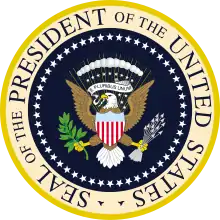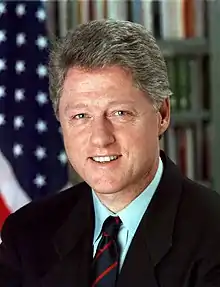Presidential transition of Bill Clinton
The presidential transition of Bill Clinton began when Bill Clinton won the United States 1992 United States presidential election, becoming the President-elect, and ended when Clinton was inaugurated at noon EST on January 20, 1993.
| Formation | November 3, 1992 |
|---|---|
| Dissolved | January 20, 1993 |
| Type | Quasi-governmental–private |
| Purpose | Presidential transition |
| Headquarters | Little Rock, Arkansas and Washington, D.C. |
Leaders | Warren Christopher (Director) Vernon Jordan (Chairman) |
| ||
|---|---|---|
Transitions
Planned transitions
|
||
| ||
|---|---|---|
|
Governor of Arkansas
President of the United States
Policies
Appointments
First term
Second term
Presidential campaigns
Controversies
Post-presidency
|
||
Pre-election developments
Clinton's presidential campaign launched an effort to plan for a prospective presidential transition in August of 1992.[1] The effort was known as the "Clinton-Gore Pre-TRansition Planning Foundation" or the "Clinton–Gore Presidential Transition Planning Foundation".[2][3] Clinton chose to have the effort be headed by his campaign chair Mickey Kantor.[4] Businessman Gerald Stern was named as the coordinator of the planning group on September 24, 1992, heading its day-to-day operations.[3][5] Assisting him was lawyer John Hart.[5] Other members of the team included Warren Christopher, Henry Cisneros, Vernon Jordan, and Madeleine Kunin.[2] The team was headquartered in Little Rock, Arkansas, in an office building only blocks away from the campaign's headquarters.[2][5] Barry Carter oversaw the national security aspects of the transition planning.[5] The team collected vast amounts of research on past presidential transitions, and compiled a large briefing books outlining a strategy for a potential transition.[2][5][1] By late-October, the transition effort had a full-time staff of between ten and fifteen people.[5] Despite the early start, few decisions about hires for Clinton's administration were outlined until after the election.[4]
On October 6, 1992, President George H. W. Bush signed an appropriation that would provide $5 million to a prospective transition. If Clinton were to win, the appropriation would give his transition team $3.5 million, and give $1.5 million to Bush's administration to aid them in the transition. This was in accordance with a 1988 increase in funding for presidential transitions to these amounts.[6]
Official transition
After Clinton defeated Bush in the election, both Bush and Clinton publicly proclaimed their desire for a smooth transition between their administrations.[7]
After the election, after tensions between Kantor and Clinton's top campaign staff had arisen, Kantor was dismissed as head of the transition effort.[4] On November 6, Warren Christopher was named as the transition director and Vernon Jordan was named to serve as the chairman of the transition's board, making them co-leaders of the transition.[4][2][8][9] Bush named Andrew Card to head the Bush administration's role in the transition.[2][10]
On November 13, Clinton named several dozen other members of his transition team. The members he named were noted by The New York Times to have, "diversity in age, sex and ethnic background".[9] Robert Reich was named to lead the economic policy team, and Sandy Berger was named to lead the foreign policy team.[9] Clinton's transition team largely consisted of individuals that had worked on his presidential campaign.[11]
On November 13, Clinton outlined ethics guidelines for his transition staff. These guidelines would forbid any staff or volunteers from, in the first fix months of the Clinton administration, lobbying the government in areas they had worked on during the transition. The ethics guidelines also required transition workers to file detailed financial disclosure forms, and forbid them from doing any work on the transition that appeared to be a conflict of interest.[9][12] These ethics guidelines received praise from the groups Common Cause and Public Citizen.[12]
On November 18, President Bush hosted President-elect Clinton at the White House.[13]
In the early weeks of the transition, the president-elect's communications director, George Stephanopoulos, said the president-elect was receiving roughly 30,000 items of mail per day.[12]
In addition to the $3.5 million the government provided the Clinton transition team, $5.3 million was raised through private contributions to fund their effort.[14]
The transition was considered chaotic, in some respects.[4][15] In late January 1993, shortly after the transition ended, historian Carl Brauer described his assessment of performance of Clinton's transition as, "mixed".[16] The transition was headquartered both in Little Rock, Arkansas and Washington, D.C., with this geographic split of the operation creating some problems.[4] The main decisions tended to be made from the Little Rock headquarters, where Clinton largely remained during the transition.[4][2] The transition's policy advisors were ideologically split between centrists and liberals.[4] Clinton's transition took longer than his predecessor to designate appointees to top positions.[4][17] The transition began publicly announcing the first his designees to be appointed to major executive branch offices six weeks after winning the election. It finished announcing them in the eleventh week following his election victory.[17] It also took Clinton particularly long to name a White House Chief of Staff, with him waiting until mid-December before naming Mack McLarty.[15]
Clinton spent great amounts of time during the transition devising plans with a intimate group of confidantes, including his wife Hillary, Vice-President-elect Al Gore, and transition director Christopher Warren.[4] Clinton deeply involved himself with the details of his new presidential administration, especially the selection of members of his Cabinet.[4] Clinton's wife was also heavily involved in making staffing decisions for his Cabinet.[4] Both Clinton and his wife had interest in making his cabinet have increased racial diversity and more women members than past cabinets.[4] The Clintons' decision to be so deeply involved in personnel decisions contributed to the delay in naming individuals to the positions.[4]
In contrast to his deep involvement Cabinet staffing decisions, Clinton paid comparatively little attention to many staffing decisions for his White House staff.[4][15] He also avoided appointing White House insiders to his administrations, making few hires of individuals that had served in the administration of the last Democratic president, Jimmy Carter.[4] Clinton appeared to demonstrate possible hostility towards hiring Washington insiders.[4] Consequentially, many of his White House hires were of individuals that had worked on his campaign, but who were largely young and lacked government experience.[4] The transition also failed to heed the advice of the outgoing Bush administration to name members of his White House staff early into his transition.[4] While Clinton refrained from hiring many veterans of past administrations, his transition team did meet for advice with members of past Democratic administrations, particularly those of John F. Kennedy, Lyndon B. Johnson, and Jimmy Carter.[8]
Clinton had roughly 4,000 executive branch positions to make appointments to, in addition to setting a budget and political agenda.[1]
Officially heading personnel selection was Richard Riley.[4] However, after Riley was named to be Clinton's choice for Secretary of Education, he found his attention divided between his role in the transition and preparing for his pending position in the presidential administration.[4]
Clinton throughout his transition, made clear that he understood that, until January 20, the country had a singular president, George H. W. Bush.[18] As the inauguration came close, Bush's advisers had begun working with Clinton's advisors, particularly on foreign policy, to ensure that there would be a smooth transfer of power. For instance, for weeks before the inauguration, Brent Scowcroft, Bush's National Security Advisor, would meet daily with Anthony Lake, who Clinton had designated to be his National Security Advisor.[18]
In December, Clinton was a participant in a televised economic summit in Little Rock. While his provided an opportunity for the president-elect to display his policy knowledge, the summit also took up valuable time during a crucial stage of his transition.[4][19]
Contoversies
Controversy arose when president-elect Clinton indicated support for allowing homosexual individuals to openly serve in the United States Armed Forces, a stance that was contrary both to the position of the Joint Chiefs of Staff and Clinton's own Democratic Party.[4]
A scandal arose about Clinton's choice for Attorney General, Zoe Baird, having failed to pay taxes for domestic servants that had been in the country illegally. The scandal became known as "Nannygate".[20] Baird's resignation would ultimately end up being withdrawn the day after Clinton's inauguration.[4]
Iraq crisis
Beginning roughly two weeks before Bush was to hand power over to Clinton, perhaps seeking to take advantage of the possible hesitancy of Bush to respond right before the end of the transition, Iraqi dictator Saddam Hussein began engaging in brinksmanship. In response, on January 13, 1993, Bush ordered a limited airstrike on Iraq. In the days before the airstrike, Clinton received detailed briefings on the situation. Bush's national security advisors spoke with the men Clinton had designated to be his when he took office. President Bush called Clinton an hour before the airstrike to inform him of the decision. While the airstrike was ultimately Bush's decision, a top Bush administration official claimed that Clinton and his own national security advisors had been "partners in the deliberations" over the airstrike. Clinton said that the airstrike was, "the right decision, done in the right way."[18][21][22][23]
External links
References
- Marshall, Matt (10 Nov 1992). "Musical Chairs in the Seat of Power". Newspapers.com. The Los Angeles Time.
- Smith, Stephanie (11 February 2008). "CRS Report for Congress Presidential Transitions" (PDF). Congressional Research Service. Retrieved 29 January 2021.
- "Clinton fills in healthcare blanks". Newspapers.com. The Indianapolis News. 25 Sep 1992. Retrieved 2 February 2021.
- Skinner, Richard (7 October 2016). "Bill Clinton set a bad example with his transition". Vox. Retrieved 1 February 2021.
- Gellman, Barton; Balz, Dan (29 October 1992). "CLINTON TRANSITION TEAM READY TO HIT THE GROUND RUNNING". Washington Post. Retrieved 3 February 2021.
- "JUST ASK Where does the money come from to pay Bill Clinton's transition team expenses?". Newspapers.com. Democrat and Chronicle. 13 Nov 1992. Retrieved 2 February 2021.
- Mann, Jim (8 November 1992). "Encounter can be icy as presidents pass torch". Newspapers.com. The Charlotte Observer. Los Angeles Times. Retrieved 2 February 2021.
- "Clinton team confers with party veterans". Newspapers.com. Santa Cruz Sentinel. The Associated Press. 21 Nov 1992. Retrieved 2 February 2021.
- Friedman, Thomas L. (13 November 1992). "THE TRANSITION: The New Team 1; Clinton Selects Diverse Team of Advisers (Published 1992)". The New York Times. Retrieved 3 February 2021.
- "Clinton Transition Gets Going". Newspapers.com. The Charlotte Observer. 8 November 1992. Retrieved 2 February 2021.
- "Stuck Out There In Transition Limbo". Newspapers.com. The Leaf-Chronicle. 14 Dec 1992. Retrieved 2 February 2021.
- King, John (14 Nov 1992). "Clinton details stringent ethics rules for aides". Newspapers.com. Intelligencer Journal. The Associated Press. Retrieved 2 February 2021.
- "Photos: Presidents in Post-Election Transition". WSJ. Retrieved 6 February 2021.
- Zausner, Robert (30 November 2000). "A new Bush fund appeal". Newspapers.com. The Philadelphia Inquirer. Retrieved 31 January 2021.
- Vyse, Graham (16 November 2016). "Bill Clinton's Transition Was Worse Than Trump's (For Now)". The New Republic. Retrieved 3 February 2021.
- Reidy, Chris (31 Jan 1993). "Bush More Lion Than Lame Duck in Last Days". Newspapers.com. Albuquerque Journal. Boston Gobe. Retrieved 2 February 2021.
- Schrader, Esther; Shogren, Elizabeth (14 Dec 2000). "Bush team must scurry to name top appointees". Newspapers.com. South Florida Sun Sentinel. Los Angeles Times.
- Rankin, Robert A.; Bennett, Susan (14 Jan 1993). "Bush, Clinton stand as one". Newspapers.com. Tallahassee Democrat. Knight-Ridder Washington Bureau.
- Weisman, Jonathan (13 Nov 2000). "Job of staffing new government can be awesome". Newspapers.com. The Record. The Baltimore Sun. Retrieved 4 February 2021.
- "Trump's pick for budget chief has a Nannygate problem". chicagotribune.com. Chicago Tribune. 30 January 2017. Retrieved 2 February 2021.
- Gellman, Barton; Devroy, Ann (14 January 1993). "U.S. DELIVERS LIMITED AIR STRIKE ON IRAQ". Washington Post. Retrieved 2 February 2021.
- Apple, R. W., Jr. (14 January 1993). "RAID ON IRAQ; U.S. AND ALLIED PLANES HIT IRAQ, BOMBING MISSILE SITES IN SOUTH IN REPLY TO HUSSEIN'S DEFIANCE (Published 1993)". The New York Times. Retrieved 2 February 2021.
- McNulty, Timothy J. (14 January 1992). "ALLIED STRIKE PUNISHES IRAQ". chicagotribune.com. Chicago Tribune. Retrieved 2 February 2021.
| Preceded by George H. W. Bush |
Presidential transition 1992-1993 |
Succeeded by George W. Bush |

